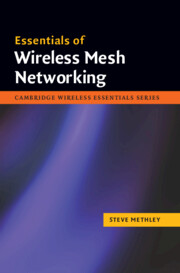Book contents
- Frontmatter
- Contents
- Preface
- Acknowledgements
- 1 Mesh overview and terminology
- 2 Attractive mesh attributes and applications
- 3 Fundamentals of mesh technology
- 4 Mesh capacity, scalability and efficiency – hypothesis testing
- 5 Mesh susceptibility
- 6 Mesh services and quality of service
- 7 Summary of potential mesh pitfalls to avoid
- 8 Appropriate telecommunications applications for mesh
- 9 Successful mesh implementations
- 10 Wireless sensor networks (WSNs) as mesh networks
- Abbreviations
- Selected definitions
- Appendix: Mobility models
- About the author
- Index
- Mesh hints and tips
7 - Summary of potential mesh pitfalls to avoid
Published online by Cambridge University Press: 01 March 2010
- Frontmatter
- Contents
- Preface
- Acknowledgements
- 1 Mesh overview and terminology
- 2 Attractive mesh attributes and applications
- 3 Fundamentals of mesh technology
- 4 Mesh capacity, scalability and efficiency – hypothesis testing
- 5 Mesh susceptibility
- 6 Mesh services and quality of service
- 7 Summary of potential mesh pitfalls to avoid
- 8 Appropriate telecommunications applications for mesh
- 9 Successful mesh implementations
- 10 Wireless sensor networks (WSNs) as mesh networks
- Abbreviations
- Selected definitions
- Appendix: Mobility models
- About the author
- Index
- Mesh hints and tips
Summary
As we have seen from the previous chapters, there are numerous key considerations to bear in mind when planning to implement a mesh. Some of these key considerations, if not properly addressed, constitute potential pitfalls for the mesh system designer. The aim of this short chapter is to bring all such considerations together for easy reference, so the pitfalls may be avoided. This is particularly appropriate as not all pitfalls have familiar equivalents outside the world of mesh networking.
In summary, potential pitfalls already covered in the body of this book centred around
capacity,
infrastructure,
efficiency,
relay exhaustion,
initial roll-out,
upgradeability,
reliance of the system on user behaviour, and
ad hoc versus quality of service.
There are also two areas which we have covered implicitly, but now wish to highlight explicitly here:
9. security and trust, and
10. system economics.
Let us deal with these areas in turn.
Capacity
In Chapter 4 we noted that it was often rumoured that meshes self-generate capacity, as if this were a truism. The reasoning behind such a claim was usually along the lines of ‘each new user brings additional capacity to the mesh’, or ‘each new user effectively becomes a base station’. This book critically examined such statements and separated the reality from a something-for-nothing type of mythology. We outlined the difference between network capacity and the user throughput which is actually available, concluding that user throughput cannot grow as fast as the mesh grows. The simple reason is the relay requirement imposed on each node, due to the traffic of other nodes.
- Type
- Chapter
- Information
- Essentials of Wireless Mesh Networking , pp. 151 - 157Publisher: Cambridge University PressPrint publication year: 2009



